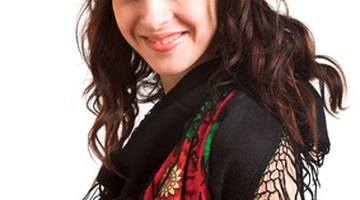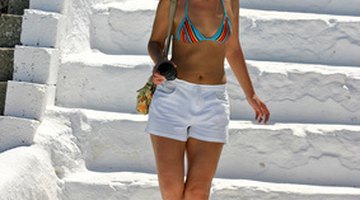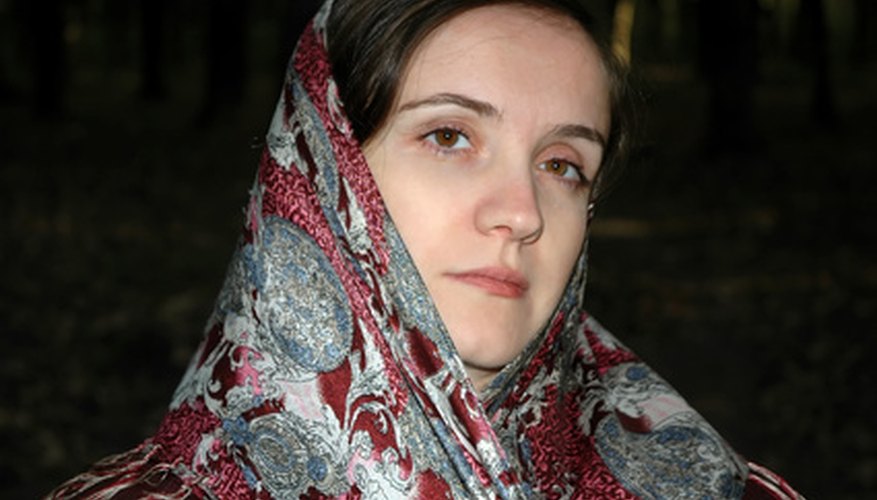A culture may be reflected in the costumes or headwear of its people. In Romania, different forms of headscarves are worn. According to an article from Eliznik on Romanian costumes, headwear and hairstyles represent women's marital status, and single girls generally have their heads uncovered. Although many types of head coverings are worn by Romanian women, the basma, or "square scarf" is most popular and seen throughout many European countries, especially in the Balkans.
- A culture may be reflected in the costumes or headwear of its people.
- According to an article from Eliznik on Romanian costumes, headwear and hairstyles represent women's marital status, and single girls generally have their heads uncovered.
Stand in front of a mirror and comb or brush hair. Leave it down or using a hair tie, form a bun or ponytail. Hair will be hidden under the scarf and can be either left down or put up. Longer hair can also be braided into one or two braids, or formed into two loops or buns on the sides of the head.

Take the printed square scarf and fold it in half to form a triangle. A basma is a square piece of cotton, silk or wool fabric and is either plain, embroidered or printed. The most popular type of basma headscarves are printed floral scarves.
- Take the printed square scarf and fold it in half to form a triangle.
Another type of headscarf, the testemel, is a triangular shaped headscarf. It is worn the same way as the basma but does not require folding. The testemel can be made of white cotton or fringed with lace and beads.
Place the scarf on your head with the long side against your forehead, holding both ends of the triangle in your hands.
Tie the ends either under your chin once or twice to form a tighter knot or under your hair at the nape of your neck. It should feel tight enough as to not slide off easily but not too tight.
Basma scarves are tied differently depending on age or region. Younger girls usually wear them tied in the back while older women wear them tied under the chin.
If the ends of the scarf are long, tie them once under the chin and bring the ends up to the top of the head and form a knot there.
- Tie the ends either under your chin once or twice to form a tighter knot or under your hair at the nape of your neck.
- If the ends of the scarf are long, tie them once under the chin and bring the ends up to the top of the head and form a knot there.
If wearing with braids, buns or loops, tie the scarf in the back over the hair so that the hairstyle is visible from underneath the scarf.
Take off the scarf by either untying the knot or sliding it off your head.
Comb or brush hair and leave it down or form a bun, ponytail, a braid or two braids.
Take the oblong cotton scarf known as the stergar or the silk veil, known as the marama into your hands. Both of these are traditional head coverings made of flax, hemp, cotton or silk and about 7 to 8 feet long, and 15 to 20 inches wide with embroidery or beads.
Fold the stergar or the marama in half and drape it over your head with the longer side against your chin, holding its ends in your hands. The stergar or marama are worn differently in various regions of Romania. They can be paired over a cap or bonnet, or a beaded headband can be worn over them.
- Comb or brush hair and leave it down or form a bun, ponytail, a braid or two braids.
- Fold the stergar or the marama in half and drape it over your head with the longer side against your chin, holding its ends in your hands.

Tie the ends of the stergar or marama loosely under your chin or in the back of your head under your hair. You may also leave the ends loose and let them hang, or throw one or both ends of the scarf over your shoulders without tying them.
If wearing your hair in a bun, wrap the ends of the stergar or marama around your bun and tie the ends to keep it in place. Another option is to wrap the ends once around your ponytail or bun and tie it once around the hair, leaving the ends hanging down your back.
